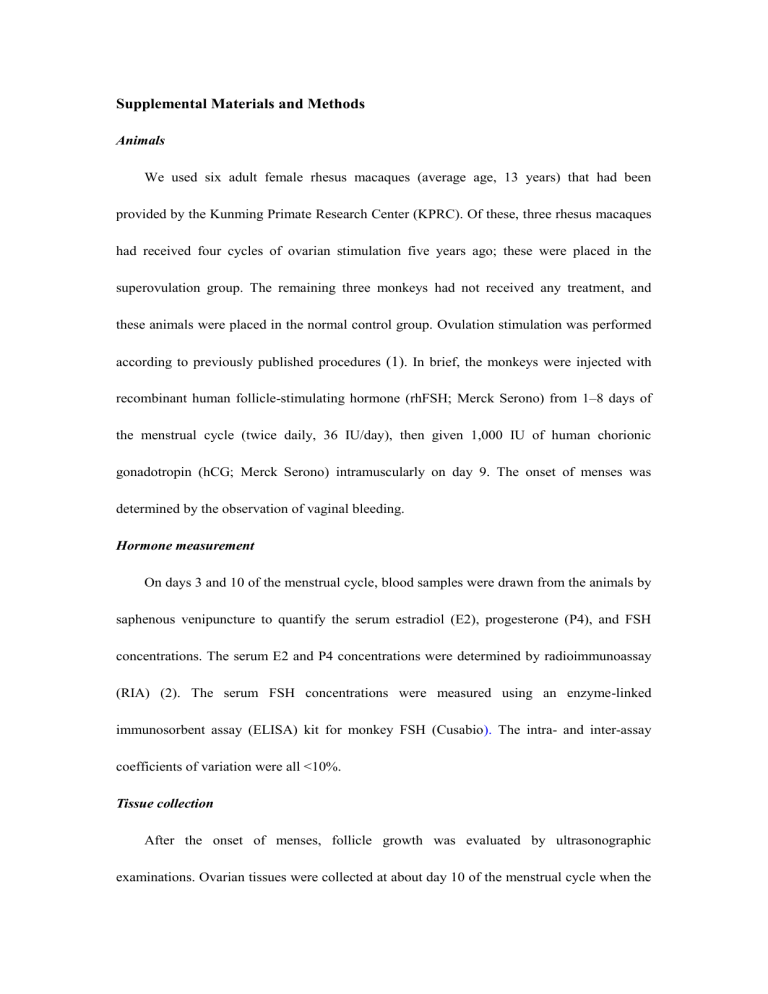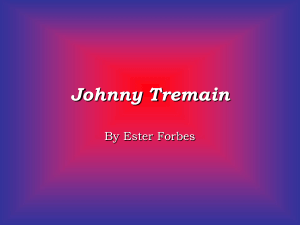Supplemental Materials

Supplemental Materials and Methods
Animals
We used six adult female rhesus macaques (average age, 13 years) that had been provided by the Kunming Primate Research Center (KPRC). Of these, three rhesus macaques had received four cycles of ovarian stimulation five years ago; these were placed in the superovulation group. The remaining three monkeys had not received any treatment, and these animals were placed in the normal control group.
Ovulation stimulation was performed according to previously published procedures (1) . In brief, the monkeys were injected with recombinant human follicle-stimulating hormone (rhFSH; Merck Serono) from 1–8 days of the menstrual cycle (twice daily, 36 IU/day), then given 1,000 IU of human chorionic gonadotropin (hCG; Merck Serono) intramuscularly on day 9. The onset of menses was determined by the observation of vaginal bleeding.
Hormone measurement
On days 3 and 10 of the menstrual cycle, blood samples were drawn from the animals by saphenous venipuncture to quantify the serum estradiol (E2), progesterone (P4), and FSH concentrations. The serum E2 and P4 concentrations were determined by radioimmunoassay
(RIA) (2). The serum FSH concentrations were measured using an enzyme-linked immunosorbent assay (ELISA) kit for monkey FSH (Cusabio ). The intra- and inter-assay coefficients of variation were all <10%.
Tissue collection
After the onset of menses, follicle growth was evaluated by ultrasonographic examinations. Ovarian tissues were collected at about day 10 of the menstrual cycle when the
follicles were in the proliferative phase. One ovary of each monkey was frozen in liquid nitrogen and used for the extraction of protein and RNA samples, which were then used for proteomic, Western blot, and real-time polymerase chain reaction (PCR) analyses. The other ovary was divided into two parts, of which one half was fixed in 4% formaldehyde for histological and immunohistochemical analysis, and the second half was fixed in glutaraldehyde solution for ultrastructural examination.
Histological and ultrastructural examination
The formaldehyde-fixed ovary tissues were embedded in paraffin blocks, which were sectioned into 5-µm-thick slices, deparaffinized, and stained with hematoxylin and eosin for histological examination. The follicle morphology was carefully observed. For ultrastructural examination, the tissue blocks were post-fixed with 2% OsO
4
and embedded in araldite.
Ultrathin sections were stained with uranyl acetate and lead citrate, and examined under an electron microscope (Jeol).
Ovarian follicle classification
Based on the criteria described previously by Buse et al., the follicles were classified as primordial (oocyte surrounded by a single layer of flattened granulosa cells), primary(oocyte surrounded by a single layer of cuboidal granulosa cells), secondary (oocyte surrounded by more than one layer of cuboidal granulosa cells), antral(follicles with an antrum lined by granulose cells and well developed internal and external theca cell layers) and atretic(follicles with a detached and apoptotic granulosa cell layer, as indicated by cell shrinkage, chromatin condensation and nuclear fragmentation) (3).
Ovarian follicle count and statistics
Three monkeys in superovulation group and three monkeys in control group were used for ovarian follicle count.
For each monkey, one ovary was serially sectioned and stained with hematoxylin and eosin. Then we counted the ovarian follicles of different stage in every 10th section, and obtained the number of each-stage follicle in this monkey. By calculating the ratio of each-stage follicle number to total follicle number, we obtained the proportion of each-stage follicle in each monkey. The follicle data obtained respectively from three superovulation monkey were compared with those obtained from three normal monkey, using unpaired two-tailed Student’s t-test. Differences were considered significant at P < 0.05.
Immunohistochemical analysis
Paraffin-embedded sections were immunostained as previously described (4) by incubation overnight at 4°C with primary antibodies against Ki67
( 1:200; monoclonal antibodies; Abcam). Then the sections were incubated with the horseradish peroxidase
(HRP)-conjugated secondary antibody (1:500). An Axioskop 2 microscope (Carl Zeiss) was then used to examine the slides treated with diaminobenzidine, and the ratio of Ki67-positive follicels was calculated. The ratio data respectively obtained from three superovulation monkey was compared with that obtained from three normal monkey, using unpaired two-tailed Student’s t-test. Differences were considered significant at P < 0.05.
TUNEL assay
Analysis of apoptosis in the ovary was carried out by the terminal deoxyribonucleotidyl transferase (TDT)-mediated dUTP-digoxigenin nick-end labeling (TUNEL) assay using an
ApopTag Plus Peroxidase In Situ Apoptosis Detection Kit (Millipore). The numbers of
TUNEL-positive granulosa cells in all the follicles per section were counted. Three individual
sections were counted per animal. The apoptotic indices were then measured by calculating the ratio of the total number of TUNEL-positive cells to the number of counted follicles. The apoptotic indices respectively obtained from three superovulation monkey was compared with that obtained from three normal monkey, using unpaired two-tailed Student’s t-test.
Differences were considered significant at P < 0.05.
Real-time quantitative PCR
Three monkeys in superovulation group and three monkeys in control group were used for real-time quantitative PCR analysis to detect the mRNA level of oocyte-specific genes or steroidogenic enzymes in the ovary tissue. Total RNA was extracted from the ovary tissue of each monkey using an RNeasy Plus Micro Kit (Qiagen). A 20-µL cDNA reaction mixture was then prepared using a PrimeScript RT reagent kit (TaKaRa). SYBR Premix Ex Taq II kits
(TaKaRa) were used for real-time PCR. Reactions were carried out according to the manufacturer’s protocol. Primer sequences and target fragment sizes are listed in
Supplemental Table 1.
As previously described(5), the mRNA level of target gene in each monkey was determined by the formula 2 △ Ct
; △ Ct = Ct (target gene) - Ct (β-actin). Then the mRNA level data obtained from three superovulation monkey were compared with that obtained from three normal monkey, using unpaired two-tailed Student’s t-test. P < 0.05 was considered statistically significant.
Western blotting
Western blotting of ovary tissue lysates was performed as previously described (4) using anti-RDH11 (1:4,000; monoclonal; Novus Biologicals), anti-RRAS2 (1:1,000; polyclonal;
Proteintech), anti-TXNDC17 (1:250; polyclonal; Abcam), and anti-
βactin (1:10,000; monoclonal; Merck Millipore).
Preparation of samples and TMT labeling
Proteins were extracted from the ovaries of all the monkeys, and protein concentrations were measured by the Bradford assay. Each 100-µg protein sample was treated as follows: reduction of cysteine residues with dithiothreitol (DTT), followed by alkylation with iodoacetamide (IAA), and digestion with trypsin. Tandem mass tag (TMT) labeling (Pierce) was performed according to the manufacturer’s protocol with minor modifications. Briefly,
TMT label reagents were equilibrated at room temperature, 41μL of anhydrous acetonitrile was added to each aliquot, and the six resuspended peptides were mixed with respective tags
(TMT 126 –TMT 131 ). After 60 min of reaction at room temperature, 8μL of 5% hydroxylamine
(w/v) was added to each tube and incubated for 15 min. The aliquots were then combined and the pooled samples were evaporated in a vacuum.
SCX fractionation
Peptide mixtures were resuspended in SCX chromatography buffer A (10mM
NH
4
COOH, 5% ACN; pH 2.7) and loaded onto cation-exchange columns (1 mm ID × 15 cm,SCX, 5 μm, 300 Å, Polysulfoethyl-Asp, Dionex) in an UltiMate® 3000 HPLC system.
The following linear gradient was used: 0% to 5% buffer B (800 mM NH
4
COOH, 5% ACN; pH 2.7) for 2 min; 5% to 23% buffer B for 22 min; 23% to 48% buffer B for 7 min; 48% to
100% buffer B for 1 min; 100% buffer B for 5 min; 100% to 0% buffer B in 1 min; and 0% buffer B for 20 min before the next run. Effluents were monitored at 214 nm using a UV light trace, and a total of 21 fractions were collected at 2-min intervals over the SCX gradient.
Mass spectrometry (MS) analysis
The 21 fractions were sequentially loaded onto a precolumn (100μm × 2 cm, nanoViper
C18 , 5μm, 100 Å, Acclaim® PepMap 100,Thermo), and transferred to a reverse-phase microcapillary column (75μm × 15cm, nanoViper C18, 2μm, 100 Å, Acclaim® PepMap
RSLC,Thermo). Reverse-phase separation of peptides was performed using the following buffers: 2% ACN, 0.5% acetic acid (buffer A), and 80% ACN, 0.5% acetic acid (buffer B) and a 221-min gradient (3% buffer B for 10 min, 3% to 5% buffer B for 3 min, 5% to 30% buffer B for 170 min, 30% to 45% buffer B for 10 min, 45% to 100% buffer B for 1 min,
100% buffer B for 8 min, 100% to 3% buffer B for 1 min, and 3% buffer B for 18 min).
The peptides were detected on an LTQ Orbitrap Velos (Thermo Fisher Scientific) by means of a data-dependent acquisition mode. The MS3 method was programmed as described by Ting et al.
(6) with minor modifications. For each cycle, one full MS scan of mass/charge ratio (m/z) = 350–1,800 was acquired in an Orbitrap mass spectrometer at a resolution of
60,000. Each full scan was followed by the selection of the eight most intense ions for collision-induced dissociation (CID) fragmentation (collision energy, 35%). The most intense product ion from the MS2 step was selected for HCD-MS3 fragmentation (NCE, 68%).
Wideband activation was enabled.
Protein identification and quantification
Raw files were searched using MaxQuant (version: 1.2.2.5) (7) against the Ensembl macaque protein database, which contains 36,384 protein sequences corresponding to 21,905 protein-coding genes (version: MMUL_1.0) (8) with the following parameters: precursor mass tolerance of ±20 parts per million (ppm); 0.5-dalton product ion mass tolerance; trypsin
digestion; up to two missed cleavages; carbamidomethylation (+57.02146 Da) on cysteine;
TMT reagent adducts (+229.162932 Da) on lysine and peptide amino termini were set as a fixed modification; and methionine oxidation(+15.99492 Da) was set as a variable modification. Other parameters were set at default. For each identified peptide, quantification signals were extracted from the corresponding HCD-MS3 spectra, protein relative expression levels were calculated according to Libra algorithm of TPP with minor modifications(9). In brief, each channel of reporter ion intensity was normalized by the sum of the signals in the corresponding channels. For each peptide, spectra with intensities that deviated from the mean by more than 2-fold of sigma were removed. Each peptide channel was then re-normalized by the sum across channels. The protein intensity was calculated as the median of normalized intensity of the corresponding peptides. Statistical significance was determined using the unpaired two-tailed Student’s t -test and differences were considered significant at P
< 0.05 and a minimum fold change of 1.5.
General annotation
The differentially expressed proteins were loaded onto the Database for Annotation,
Visualization, and Integrated Discovery (DAVID) (10) to identify their subcellular localization.
The cellular processes influenced by differentiated proteins were analyzed using
PathwayStudio TM (version: 6.0) software (Ariadne Genomics). The text-mining software uses a database of molecular networks assembled from scientific abstracts and a manually created dictionary of synonyms to recognize biological terms (11). The cellular processes influenced by the various treatments were determined by searching the database for the imported
gene/protein and for the cellular processes in which the imported genes/proteins are involved.
In our analysis, each identified cellular process was confirmed manually using the relevant
PubMed/Medline hyperlinked abstracts.
Statistical analysis
Data were expressed as means ± standard deviation (SD). Statistical significance was determined using the unpaired two-tailed Student’s t -test and differences were considered significant at P < 0.05.
References
1. Yang S, He X, Niu Y, Wang X, Lu B, Hildebrandt TB et al.
Dynamic changes in ovarian follicles measured by ultrasonography during gonadotropin stimulation in rhesus monkeys.
Theriogenology 2009;72:560-5.
2. Yang S, Shen Y, Niu Y, Hildebrandt TB, Jewgenow K, Goeritz F et al.
Effects of rhFSH regimen and time interval on ovarian responses to repeated stimulation cycles in rhesus monkeys during a physiologic breeding season. Theriogenology 2008;70:108-14.
3. Ethun KF, Wood CE, Parker CR, Jr., Kaplan JR, Chen H, Appt SE. Effect of ovarian aging on androgen biosynthesis in a cynomolgus macaque model. Climacteric 2012;15:82-92.
4. Zhu YF, Cui YG, Guo XJ, Wang L, Bi Y, Hu YQ et al.
Proteomic analysis of effect of hyperthermia on spermatogenesis in adult male mice. J Proteome Res 2006;5:2217-25.
5. Schmittgen TD, Livak KJ. Analyzing real-time PCR data by the comparative C(T) method. Nat Protoc 2008;3:1101-8.
6. Ting L, Rad R, Gygi SP, Haas W. MS3 eliminates ratio distortion in isobaric multiplexed quantitative proteomics. Nat Methods 2011;8:937-40.
7. Cox J, Mann M. MaxQuant enables high peptide identification rates, individualized p.p.b.-range mass accuracies and proteome-wide protein quantification. Nat Biotechnol
2008;26:1367-72.
8. Kinsella RJ, Kahari A, Haider S, Zamora J, Proctor G, Spudich G et al.
Ensembl
BioMarts: a hub for data retrieval across taxonomic space. Database (Oxford)
2011;2011:bar030.
9. Deutsch EW, Mendoza L, Shteynberg D, Farrah T, Lam H, Tasman N et al.
A guided tour of the Trans-Proteomic Pipeline. Proteomics 2010;10:1150-9.
10. Huang da W, Sherman BT, Tan Q, Kir J, Liu D, Bryant D et al.
DAVID Bioinformatics
Resources: expanded annotation database and novel algorithms to better extract biology from large gene lists. Nucleic Acids Res 2007;35:W169-75.
11. Nikitin A, Egorov S, Daraselia N, Mazo I. Pathway studio--the analysis and navigation of molecular networks. Bioinformatics 2003;19:2155-7.









